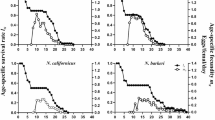Abstract
The myceliophagous mite Microdispus lambi has become a veritable plague since 1996, when it was first observed in Spanish mushroom crops, and is now causing substantial economic losses, particulary in spring and summer. This study looks at seasonal variation of the pest, its distribution on commercial farms and the population development during the crop cycle of the common white mushroom, Agaricus bisporus. Over a period of 18 months, 24 consecutive mushroom crop cycles were monitored and a total of 24 spawn and 960 substrate samples were analysed. We found that it is usually the substrates in the growing rooms that are infested, most commonly the compost. In many cases, the pest can be detected when the first ‘flush’—i.e., mushroom growth surge, with weekly periodicity—is harvested, although damage does not become evident until the third flush. Mites were detected at the back of the mushroom growing room and, to a lesser extent, near the access door.



Similar content being viewed by others
References
Clift AD (1987) A computer model to simulate the occurrence and increase in numbers of several insect and mite pests of cultivated mushrooms in Australia. In: Wuest PJ, Royse DJ, Beelman RB (eds) Cultivating edible fungi. Elsevier, Amsterdam, pp 371–378
Clift AD, Larsson SF (1987) Phoretic dispersal of Brennandania lambi (Kraczal) (Acari: Tarsonemida: Pygmephoridae) by mushroom flies (Diptera: Sciaridae and Phoridae) in New South Wales, Australia. Exp Appl Acarol 3:11–20
Clift AD, Toffolon RB (1981a) Biology, fungal host preferences and economic significance of two pygmephorid mites (Acarina: Pygmephoroidae) in cultivated mushrooms, New South Wales, Australia. Mushroom Sci 11:245–253
Clift AD, Toffolon RB (1981b) Insects and mites associated with mushroom cultivation on three commercial farms near Sydney N.S.W., Australia. Mushroom Sci 11:537–549
Ferragut F, Gea FJ, García-Morrás JA (1997) El ácaro del champiñón Brennandania lambi (Krczal) (Acari: Pygmephoriodea): introducción en España, importancia económica y separación de especies afines. Bol San Veg Plagas 23(2):301–311
Gao JR, Zou P (2001) Biology, life table and host specificity of the mushroom pest, Brennandania lambi (Acari: Pygmephoroidea). Exp Appl Acarol 25:187–202
Gao JR, Zou P, Ma EP (1986) Two new records of mushroom pygmephorid mites from China (Acari: Pygmephoridae). Acta Agric Shanghai 2(3):27–32
Krczal H (1964) Pygmephorus lambi, eine neue Pyemotide aus Champignonkulturen. Zool Anz Bd 172, Heft 4
Rivas-Martínez S, Rivas-Saenz S (1996--2009) Worldwide Bioclimatic Classification System. Phytosociological Research Center, Spain. http://www.globalbioclimatics.org
San Antonio JP, Civerolo EL, Lawson RH (1974) Diagnosis of pests, diseases, and other problems of the cultivated mushroom, Agaricus bisporus. Mushroom Sci 9:109–123
SAS Institute (2002–2003) The SAS System Version 9.1 for Windows. SAS Institute, Cary, NC
Solomon ME (1945) Tyroglyphid mites in stored products. Methods for the study of population density. Ann Appl Biol 32:71–75
Wu J-F, Ma E-P (1988) Studies on biological characters of Brennandania lambi (Krczal) the most harmful mite for mushroom production in Shangai region. Acta Agric Shangai 4(3):41–46
Wu J, Zhang Z-Q (1993a) Host feeding, damage and control of the mushroom pest, Brennandania lambi (Acari: Pygmephoroidea) in China. Exp Appl Acarol 17:233–240
Wu J, Zhang Z-Q (1993b) Control of Brennandania lambi (Acari: Pygmephoroidea) by freezing: evaluation of its efficacy and effects on mushroom growth and yield. Exp Appl Acarol 17:531–540
Acknowledgments
Funding for the research was provided by the Ministry of Agriculture, Fisheries and Food of Spain, I.N.I.A.-Proyects SC98-011-C3 and RTA01-017-C3.
Author information
Authors and Affiliations
Corresponding author
Rights and permissions
About this article
Cite this article
Navarro, MJ., Gea, FJ. & Escudero-Colomar, L.A. Abundance and distribution of Microdispus lambi (Acari: Microdispidae) in Spanish mushroom crops. Exp Appl Acarol 50, 309–316 (2010). https://doi.org/10.1007/s10493-009-9326-3
Received:
Accepted:
Published:
Issue Date:
DOI: https://doi.org/10.1007/s10493-009-9326-3




